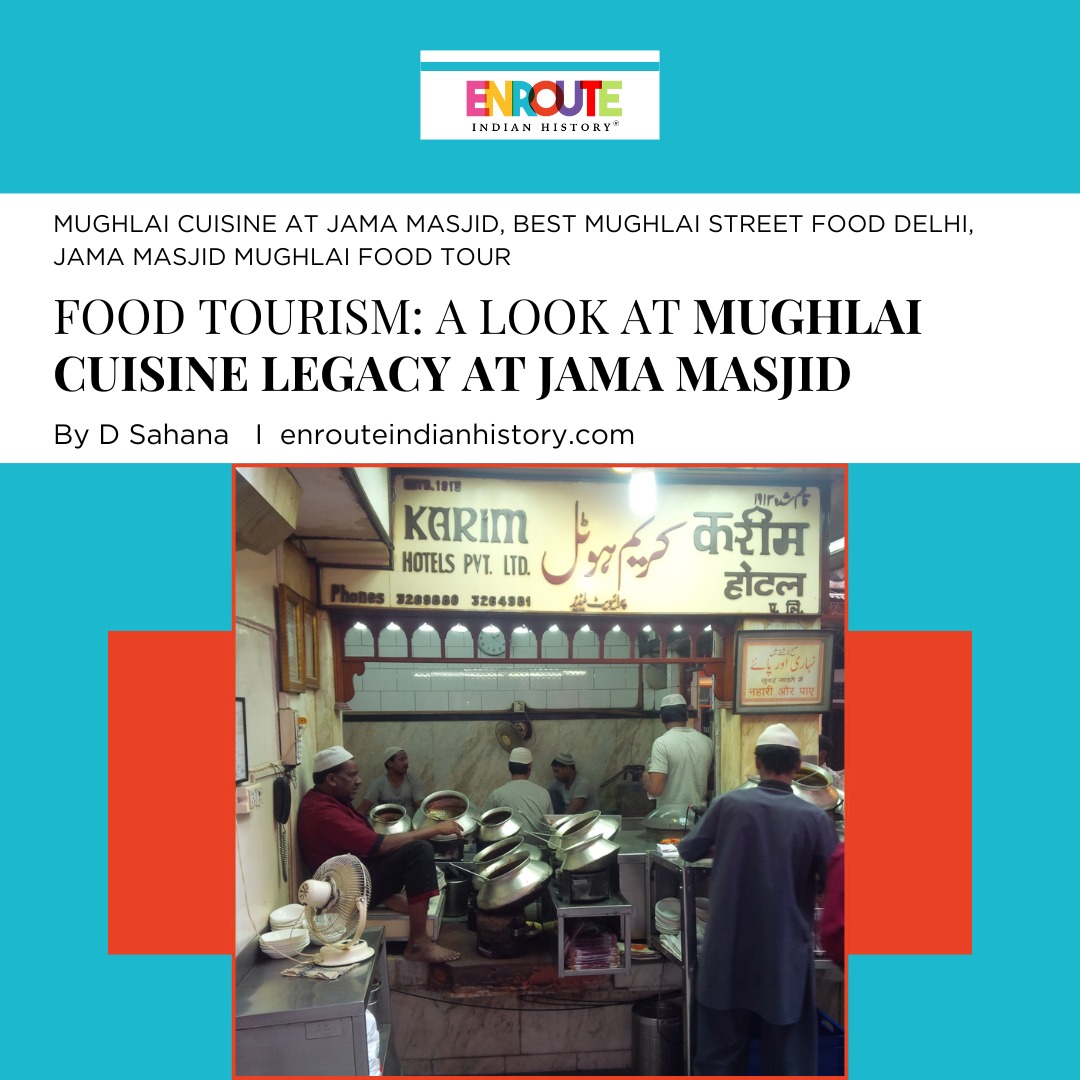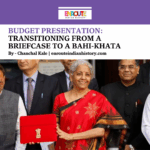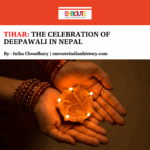
 Indian food is a product of different food cultures and practices which have been passed down for centuries. Different regions have their styles of food preparation and eating culture; despite this, they all come together and form the giant umbrella of Indian food. Here, we will look at how the Mughals brought different culinary inspirations and practices that brought a rich cultural diversity into the eating and cultural practices of the subcontinent. We also look at how this was translated into the food scene with a focus on the food history of Jama Masjid and looking at one of the most famous restaurants, Karim’s.
Indian food is a product of different food cultures and practices which have been passed down for centuries. Different regions have their styles of food preparation and eating culture; despite this, they all come together and form the giant umbrella of Indian food. Here, we will look at how the Mughals brought different culinary inspirations and practices that brought a rich cultural diversity into the eating and cultural practices of the subcontinent. We also look at how this was translated into the food scene with a focus on the food history of Jama Masjid and looking at one of the most famous restaurants, Karim’s.

Indian Spices
(source: By Joe mon bkk – Own work, CC BY-SA 4.0, https://commons.wikimedia.org/w/index.php?curid=38878979 Wiki Commons)
Tulasi Srinivas writes that food helps one understand the everyday Indian culture and the complexities of identity. She quotes anthropologist Theodore Bestor and writes, “Culinary imagination is a way a culture conceptualises and imagines food”. This process can also be seen in how the Mughals interacted with foods native to the subcontinent, incorporated these elements and brought in a newer kind of culinary imagination: the Mughlai cuisine.
WHAT IS MUGHLAI CUISINE?
As mentioned, Mughlai food, simply put, is the product of an interaction between the pre-existing native foods and the newer foods and cooking techniques. The Mughals brought new foods to the subcontinent from Central Asia, such as dried fruits, pilafs, leavened wheat breads, stuffed meat, poultry, and fruits. The Mughals also brought new cooking processes, such as baking bread and cooking meat on skewers in the tandoor, a cylindrical clay oven, braising meats and poultry, and tenderising meats using yoghurt. They incorporated native ingredients such as spices (cardamom, pepper, and clove) and vegetables, such as brinjal, to cook their foods, which gave birth to Mughlai cuisine. One must note that this style of cooking was not just restricted to the Mughal territory; it also spread far and wide, so much so that one also finds many Mughlai foods in modern Indian kitchens.

Seekh Kebab
(Source: By Srishti Gurung – Own work, CC BY-SA 4.0, https://commons.wikimedia.org/w/index.php?curid=40989409 Wiki Commons)
WHAT WAS USED TO PREPARE A MUGHLAI DISH?
A typical Mughlai dish tends to go heavy on spices and is meaty. Different spices such as cumin, coriander, turmeric, pepper, nutmeg and ginger were used. Spices such as saffron were also used to bring a floral scent to the dishes. Mughlai cuisine is also famous for its varieties of desserts, such as panbhatta, gulgula, malida, sharbat, falooda etc.
COOKBOOKS
When one looks at the sources for understanding Mughlai cuisine, Ni’matnama (the Book of Delights)comes to mind, as it was one of the first records of a medieval Indian cookbook. It was a cookbook compiled by Ghiyath Shah, the Sultan of Malwa, in the fifteenth century. This text was written in Naskh script. The manuscript is believed to have reached the Mughal kitchens in 1562 when Akbar conquered the Malwa Sultanate. The book has detailed recipes with miniature illustrations. The king is the central figure of the drawings and notes dishes, classifies them as worthy of being served to a king, a poor man’s food, or a king’s favourite.
In the Ni’matnama, there are recipes for a variety of sambusas. Sambusas are pastries of refined flour, then filled with a savoury, spicy filling and fried. There is also a variety of fillings in sambusas. Today, samosas in India tend to have potato and pea filling; however, meat-filled samosas are also famous.

Nimat-nama (Book of Delicacies) Malwa, 15th century
(Source: Wiki Commons)
The Ni’matnama also mentions several dishes, like seekh, kabab, yakhni, shurba, and kufta. These dishes help us locate their Central Asian origin. Seekh is a cylinder of spiced minced meat on a skewer roasted on a tandoor. Yakhni is broth made with spiced meat, while shurba is a soup. Apart from the typical spices, exotic spices, such as musk (nutmeg), camphor, rosewater, and ambergris, were also used. Apart from the different spices and aromatics, different kinds of meat, including meats of partridges, rabbits, goats, mountain sheep, pigeons, and quails, were also used in recipes. During Mughal times, rice was prevalent, and because of this, we also see the extreme popularity of Khichri, a rice-based porridge. The popularity of Khichri was such that each ruler had their own variation of Khichri.

Khamiri Roti
(source: By Twit Rajat – Own work, CC BY-SA 4.0, https://commons.wikimedia.org/w/index.php?curid=40989446 Wiki Commons)
Nushka-i-Shahjahani is another cookbook which helps us look into the Mughal kitchens, especially during the reign of Shah Jahan, the fifth Mughal emperor. Nushka-i-Shahjahani mentioned several kinds of breads and stews as well as sweetmeats. The ten chapters on food describe the varieties of breads, pottages, meat dishes, and other rice preparations like pulao and zerbiryans. Among the breads, there are recipes for naan (leavened oven-baked flatbread) and roti (round flatbread made from wholemeal flour). There is also mention of a wide variety of desserts and sweetmeats.
SPREAD OF MUGHLAI FOOD IN THE FOOD SCENE OF DELHI
Delhi has not just been a city of art and architecture; Delhi has also been extremely popular for its food scene, especially the street food scene. Famous food critic and historian Pushpesh Pant (2013) has compared the food of Delhi to a “Lachha Parantha” (layered bread), where each layer adds to the diverse character of its cuisine. This can be seen in Delhi’s history of food; different rulers brought different changes, like how the Mughals brought the Central Asian- Persian style of cooking and later, the British brought in the European style of cooking and how post-independence different communities brought their style of cooking with them.
THE MOST POPULAR RESTAURANT AT GALI KABABIAN, JAMA MASJID: KARIM’S
Karim’s history goes way back to the 19th century; it was said that Mohammad Aziz was a cook in the royal court in Delhi’s Red Fort. However, with the rebellion in 1857 and the eventual British takeover of authority, he and his sons fled the city. However, In 1911, the year the British authorities celebrated making Delhi the new capital of their empire, i.e. the Delhi Durbar, one of Aziz’s sons, Haji Karimuddin, came up with the idea of setting up a simple stall outside the gates of the Jama Masjid mosque which was built in the 17th century. He offered just two dishes – mutton with potatoes and lentil curry. Two years later, he opened a small eatery in a nearby alleyway that could cater for 20 people. He named it Karim, one of the 99 names of God in Islam. It means ‘the bountiful and generous one’.

Karim’s Hotel in Old Delhi
(Source: http://www.harekrsna.com/sun/features/04-10/features1712.htm, Public Domain, https://commons.wikimedia.org/w/index.php?curid=21054876 Wiki Commons)
This restaurant has been so influential and popular that it has spread across different cities in India. This restaurant stands strong even after being in business for over 100 years. Karim’s has been a one-stop destination for many visitors to the Jama Masjid. Now, more than 40 dishes are available at Karim’s; from simple dishes such as seekh kebab, which is prepared with minced meat with spices, there are also dishes such as fried brains (Bheja fry) on their menu. There is also a provision for ordering an entire roasted baby goat by reserving it a day prior.
Karim’s now is not just a restaurant, but rather a nostalgia, a gateway to exploring the Old city of Delhi, which takes one back to the older times with one bite of its food. Even though there are many restaurants in the Jama Masjid area, from older traditional restaurants to modern cafes and restaurants, Karim’s remains popular despite all these changes.
References:
Antani, V. and Mahapatra, S. (2022) ‘Evolution of Indian cuisine: a socio-historical review,’ Journal of Ethnic Foods, 9(1). https://doi.org/10.1186/s42779-022-00129-4.
Buncombe, A. (2013) ‘Fit for an emperor: Old Delhi’s most enduring restaurant Karim’s celebrates its centenary | The Independent,’ The Independent, 29 April. https://www.independent.co.uk/life-style/food-and-drink/features/fit-for-an-emperor-old-delhi-s-most-enduring-restaurant-karim-s-celebrates-its-centenary-8586968.html.
Chatterjee, S. and Suklabaidya, P. (2021) ‘Food image and acceptability of local cuisine: Exploring culinary tourism in Delhi,’ Atna Journal of Tourism Studies, 15(1), pp. 1–15. https://doi.org/10.12727/ajts.23.1.
Srinivas, T. (2011) Exploring Indian culture through food. https://www.asianstudies.org/publications/eaa/archives/exploring-indian-culture-through-food/.
- Authentic Mughlai cuisine Delhi
- Best Mughlai street food Delhi
- Exploring Mughlai food Jama Masjid
- Jama Masjid food experience
- Jama Masjid Mughlai food tour
- Karim’s Jama Masjid review
- Karim’s Mughlai restaurant Delhi
- Mughlai cuisine at Jama Masjid
- Mughlai food history Jama Masjid
- Mughlai food legacy Delhi
- Street food at Jama Masjid
- Traditional Mughlai dishes Delhi



















